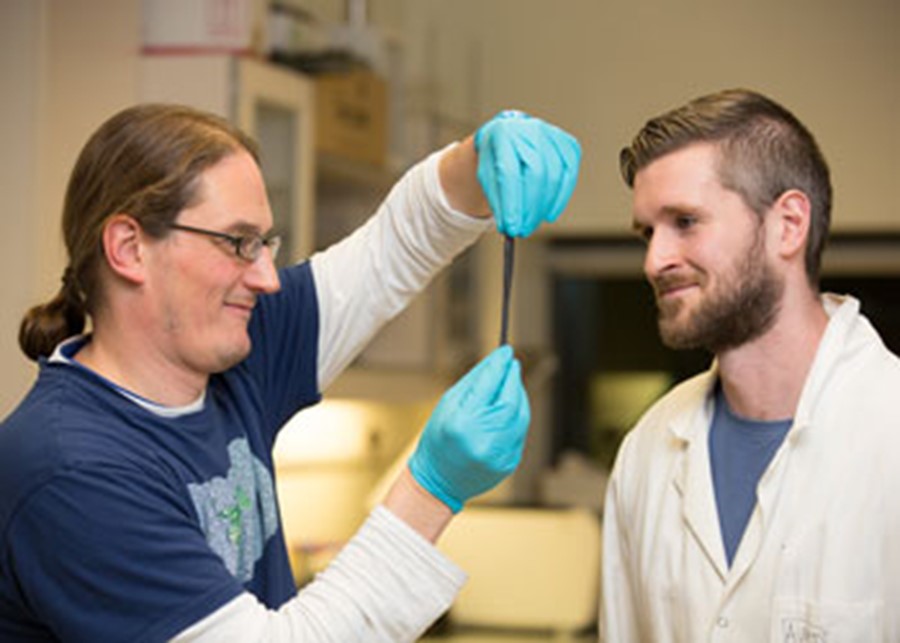G-Putty sensors - an unexpected breakthrough
Johnny Coleman investigates G-Putty but his son Oisin prefers Silly Putty®. Credit: AMBER, Trinity College Dublin
Graphene Flagship researchers from Trinity College Dublin in collaboration with the National Graphene Institute (NGI) at The University of Manchester, have used graphene to make a polysilicone polymer, known commonly as the novelty children’s material Silly Putty®, conduct electricity. Using this conductive polymer they found that they were about to create sensitive electromechanical sensors. The team’s findings have been published in the journal Science*.
This research, led by Professor Jonathan Coleman, Trinity College Dublin, in collaboration with Professor Robert Young of The University of Manchester, potentially offers exciting possibilities for applications in new, inexpensive devices and diagnostics in healthcare and other sectors.
Professor Coleman, Investigator in AMBER and Trinity’s School of Physics along with postdoctoral researcher Conor Boland (both seen in the image below), discovered that the electrical resistance of putty infused with graphene (‘G-putty’) was extremely sensitive to the slightest deformation or impact, having a gauge factor >500. They mounted the G-putty onto the chest and neck of human subjects and used it to measure breathing, pulse and even blood pressure. It showed unprecedented sensitivity as a sensor for strain and pressure, hundreds of times more sensitive than current sensors. The G-putty also works as a very sensitive impact sensor, able to detect the footsteps of small spiders.
Professor Coleman said: “What we are excited about is the unexpected behaviour we found when we added graphene to the polymer, a cross-linked polysilicone. This material is well known as the children’s toy Silly Putty. It is different from familiar materials in that it flows like a viscous liquid when deformed slowly but bounces like an elastic solid when thrown against a surface. When we added the graphene to the silly putty, it caused it to conduct electricity, but in a very unusual way. The electrical resistance of the G-putty was very sensitive to deformation with the resistance increasing sharply on even the slightest strain or impact. Unusually, the resistance slowly returned close to its original value as the putty self-healed over time.”
He continued, “While a common application has been to add graphene to plastics in order to improve the electrical, mechanical, thermal or barrier properties, the resultant composites have generally performed as expected without any great surprises. The behaviour we found with G-putty has not been found in any other composite material. This unique discovery will open up major possibilities in sensor manufacturing worldwide.”
In their paper the team show that following the addition of graphene to the polymer it not only became conductive (reaching approximately 0.1 S/m at approximately 15 volume % of graphene) but importantly, it retained its viscoelasticity characteristics. The graphene sheets are able to respond to polymeric deformation in a time dependant manor, forming networks that break and reform during mechanical deformation. This changes the conductivity of the polymeric material, enabling it to sense by deformation.
Following the initial development work at Trinity College Dublin scientists at the NGI at The University of Manchester analysed the structure of the material and were able to develop a mathematical model of the deformation of the material which explains the effect of its structure upon its mechanical and electrical properties.
Robert Young, Professor of Polymer Science and Technology at the NGI said: “The endless list of potential applications of graphene, never ceases to amaze me. We have now developed a new high-performance sensing material, ‘G-putty’, that can monitor deformation, pressure and impact at a level of sensitivity that is so precise that it allows even the footsteps of small spiders to be monitored.
“It will have many future applications in sensors, particularly in the field of healthcare. The collaboration has been undertaken under the umbrella of the European Graphene Flagship, in which Trinity College Dublin and The University of Manchester both play a prominent role. It is an excellent example of what is being achieved in the Flagship programme.”
Professor Andrea Ferrari, Science and Technology Officer of the Graphene Flagship and Chair of its Management Panel, stated "graphene never ceases to amaze, and this is yet another example. The Roadmap for applications of graphene and related materials has identified sensors, composites and biomedical applications as clear areas of interest, and this result validates the path taken by the Flagship".
* Sensitive electromechanical sensors using viscoelastic graphene-polymer nanocomposites, Boland et al., Science 9 Dec 2016
Image: AMBER, Trinity College Dublin

Image: AMBER, Trinity College Dublin
This unique discovery will open up major possibilities in sensor manufacturing worldwide.”



